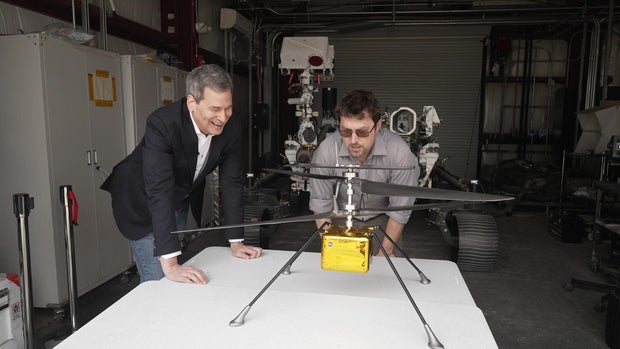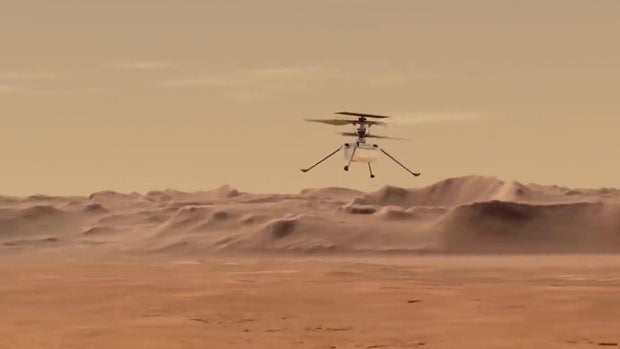In 2020, NASA’s Perseverance rover was launched to Mars with a stowaway: a small drone, created by NASA’s Jet Propulsion Laboratory in Pasadena, California.
The drone, called Ingenuity, was compared to a Wright brothers plane on Mars, making the first flight on another planet. The entire drone had to be very light, as Mars only has 1% of Earth’s atmosphere; that’s difficult for a flying machine. Therefore, Ingenuity weighs just two kilograms.
NASA has classified Ingenuity as a technology demonstration: a low-budget, high-risk parallel experiment that incorporates off-the-shelf parts to save money.
CBS News
But project manager Teddy Tzanetos said the idea of a clandestine technology demonstration, stored beneath the Rover, was not universally and enthusiastically accepted. “No, it wasn’t! There were definitely people against it, not just concerned, but sincerely against it and trying to stop it from happening,” he said. “Mars 2020, to be fair, was a science mission: go get some samples and get ready to bring them back home.
In the end, NASA decided that Ingenuity could fly, briefly – five times, at most, in the first 30 days. After that, there is no more distraction from the main quest.
By some miracle, Ingenuity survived the seven-month trip to Mars, the landing sequence, and disembarkation.
NASA/JPL-Caltech/MSSS
The distance between Mars and Earth means it takes up to 20 minutes for a signal to reach the helicopter. Therefore, all instructions would have to be conveyed in advance. “We’ll uplink a flight on Monday and if we’re lucky we’ll get the data on Tuesday, sometimes it’s longer,” said chief engineer Travis Brown.
Therefore, no one will be able to know whether it was a smoking pile of debris on Mars until days later.
On April 19, 2021, the team received confirmation of the drone’s first very short flight – the first flight of a powered aircraft on another planet! But the hardest part wasn’t flying; he was surviving the frigid nights of Mars, which can drop as low as -80° Fahrenheit.
“The joke is that Ingenuity is a battery and a heater that flies every now and then,” Brown said. “Most of the mass is battery, and most of that battery is actually spent on heating.”
NASA
Despite the cold, the helicopter flew four more times – five flights in total. Mission complete! But then, an administrative miracle: “When people saw this thing flying and taking pictures, I think everyone realized that this is more than just a toy, it’s a real flying machine,” said Håvard Grip, who was the pilot- head of Ingenuity. . “NASA told us, ‘Hey, you can continue, okay? Can you explore on behalf of the rover so we can see where the best entry points are into this area?”
Ingenuity was no longer a technology demonstration. NASA promoted it as the rover’s eye in the sky, exploring the future to help the rover choose its routes and destinations.
So, Ingenuity continued flying, breaking its own records for distance, speed, altitude and duration. And not just for 30 days… for a hundred. Two hundred. Four hundred. Through the long spring, summer and autumn of Mars.
But then, winter arrived.
On mission day 427, there was radio silence from Ingenuity. “And then the first thing you think is, ‘Okay, well, the battery froze, everything broke, we’re probably dead,” Brown said. “The mission is over, right?”
For three days, the team tried to get an answer. And then, on the third day, another miracle. “And behold, he came again and spoke to us!” said Grip.
Tzanetos said, “In the morning, when the sun came up and the system had thawed and charged enough, the electronics turned on. And we would say, ‘Here’s your flight plan, go ahead and fly now in the late afternoon.’ And she would make that flight knowing full well – the controllers here on Earth – that she would freeze again the next day.”
So Ingenuity froze to death every night all winter and then thawed again in the morning? “Yes, hundreds of times!” Brown laughed.
“It was like Groundhog Day,” Tzanetos said, “until finally you got through winter and into spring again.”
NASA
But even Ingenuity didn’t have an endless supply of miracles. Last January, NASA received the bad news: Ingenuity suffered a hard landing. “The top blade is cut off on one side and completely missing on the other,” Brown said. “We’re losing enough of the rotor system, there’s no way it can fly [again]. But I mean, this thing is still working. I spoke to this this morning. We can still collect solar data. We can still take photos.”
It’s true: three years after the end of its mission, the helicopter is still in operation, now as a ground station. We no longer receive his photos and measurements, because the Rover was his relay station and the Rover moved on. But Ingenuity could continue collecting data for decades, to be retrieved later.
Tzanetos said, “We have a phrase on the team: ‘WNDY: We’re not dead yet.'”
The “little helicopter that could” changed NASA’s thinking forever. “We have been working on the next generation of helicopters for Mars – larger, more capable helicopters, [to] go to areas like a cliff wall, fly through a lava tube, go to the poles, go to the equator, you name it,” Tzanetos said.
NASA/JPL-Caltech/LANL/CNES/CNRS
As for the Wright brothers analogy? It turns out that Mars’ stowaway helicopter housed a stowaway of its own: According to Tzanetos, “The fabric used for the wings in the Wright Brothers brochure, we have a small dime-sized piece underneath the helicopter’s solar panel, and it’s ours.” little good luck charm and ballast for the baby.”
And did everyone in the chain of command know this existed? “No, no, no. I was sworn to secrecy about some details for this, but no, the whole chain was no aware of this,” said Tzanetos.
In total, Ingenuity flew 72 times over a thousand days, for a total of more than two hours in the rarefied air of Mars, traveling more than 16 kilometers across the Martian surface. Brown gave credit to “a small, scrappy team of engineers who were very, very passionate about what they were doing.”
According to Tzanetos, “it has a special place in NASA history for being the first flight on another planet.”
“We’re all amazed; everyone here is amazed,” Grip said. “We didn’t expect this and we are very proud of it.”
For more information:
Story produced by John Goodwin. Editor: Ben McCormick.


























